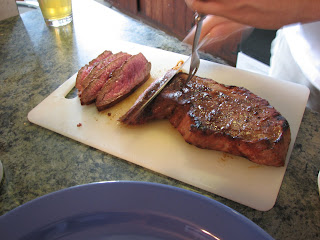A relative newcomer at the butcher's, the flat iron cut has become one of the best-selling steaks in both grocery markets and restaurants. It has been described as having the tenderness of a tenderloin and the taste of a sirloin. The flat iron steak comes from the blade roast of the beef shoulder or chuck. There is a thick piece of connective tissue that runs directly through the center of it and therefore it had never been marketed as a steak. But once that connective tissue was removed, meat science students realized there was a very tender steak with a great beefy taste as though it were near ribs.
What makes it even more popular is the price. Because it is removed from the chuck, just about the cheapest area of beef, flat iron steaks are very affordable. The trimmed top blade or flat iron (supposedly named because it looks like an old-fashioned metal flat iron) is uniform in thickness and rectangular in shape.
It can be cooked as you'd cook any other premium steak. As any non-loin steak, the flat iron benefits from marinating because it absorbs flavors beautifully, and is best if you don't cook it beyond medium. Its strong, deep, rich beef flavor makes it perfect not only on its own, but also as an ingredient for many dishes. Because it is similar to flat steaks, you could use it in recipes calling for skirt or flank steak.
I elected to marinate and grill our steak. Here's what I did...
Grilled Flat Iron Steak with Chili, Garlic, and Lime
Serves 2
1 to 1 1/2 lb flat iron steak
juice of 2 limes
4 tsp olive oil
4 cloves of garlic, minced
2 tsp chili powder
2 tsp ground cumin
1 tsp red pepper flakes
1 1/2 tsp kosher salt
1 tsp coarse ground pepper
Combine all ingredients in a zip-top plastic bag.
Once it is sealed, use your hands to thoroughly distribute the marinade over the meat. Marinate in the refrigerator for at least an hour and no more than 4 hours.
Heat your grill to medium high. Place your steak on the grill. Use these cooking times to cook your steak to medium: 2 to 3 minutes per side for a 1/2-inch thick steak, 4 to 6 minutes per side for a 1-inch thick steak, and 6 to 9 minutes for a 1 1/2 to 2-inch thick steak.
Once you take the steak off the grill, let the meat rest for 2 or 3 minutes to allow the juices to reabsorb into the steak before serving. I was so eager to eat it after letting it rest that I forgot to take a picture!
Sour cherry pudding cake
6 days ago

































































